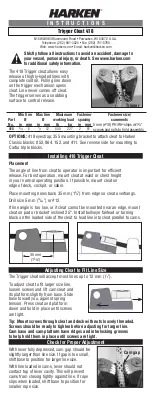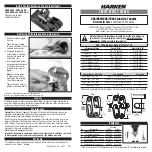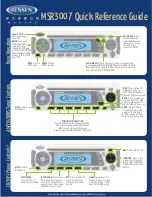
15
3.2
LOWERING THE ANCHOR UNDER POWER
Ensure the clutch is fully engaged by inserting the
clutch nut lever in one of the slots on the clutch
nut, and turning clockwise firmly. The windlass is
equipped with a friction clutch, so it can be
engaged in any position (there is no need to
match the position of the opposite sides of the
clutch before engaging it).
Remove clutch handle.
Release band brake or pawl (whichever is fitted).
Disengage chain stopper and chain tensioner (if
fitted). To disengage the chain stopper pawl the
windlass may require momentary jogging in the
up direction.
The windlass may now be lowered under power
by operating either the hand held pendant control,
helm switch or footswitch.
When finished, turn off the isolator switch for the
controls.
!
As a safety feature all buttons on the controls
(pendant, toggle switch or footswitch) non-
latching and the windlass will continue to
operate up or down only while the switch is
physically held in the engaged position.
Picture 3.1
Engaging the clutch.
3.3
RETRIEVING THE ANCHOR UNDER POWER
Ensure the clutch is engaged, as described
above, and band brake or pawl is released.
Remove clutch handle from the clutch nut.
Release tensioner. If a pawl type chain stopper is
used, it can be left ratcheting on the chain, so it
will engage itself automatically when the windlass
stops.
The windlass may now be operated to raise the
anchor.
After retrieving the anchor, make sure the chain
stopper and tensioner are engaged.
Turn off the isolator switch for the controls.
!
It is regarded as sound practice to motor over the
anchor position and so reduce chain tension. This
will also help the anchor to break out, reduce the
power consumption and reduce load on the
windlass and deck gear.
!
Care should be exercised when docking the
anchor to avoid damage to the anchor pocket.
Jog in the last meter (3-
4’) of the chain carefully
seating the anchor home.
3.4
LOWERING THE ANCHOR UNDER MANUAL CONTROL
This method will normally be employed to lower the
anchor quickly, to lower it in "quiet ship" and in
emergencies (power loss or control failure).
Proceed as follows:
Tighten the clutch and band brake (if fitted).
Release the chain stopper and chain tensioner. If
the anchor has to be lowered in case of power
loss and pawl on the chain stopper is engaged
and under tension (by chain), to release it, pull
the chain in slightly, using tensioner. Once the
pawl is disengaged, release the tensioner and
disengage it. If there is too much slack in the
chain, it might be necessary to remove the domed
nut from the end of lead screw and release the
screw completely. If doing that, make sure the
band brake and clutch is still engaged, for safety
reasons (see Picture 3.2).
Fully disengage the clutch by turning the clutch
nut anticlockwise until it comes to a stop.
Slowly release the band brake in a controlled
manner. The chain should now release, the
weight of self-launching anchor being sufficient to
!
It is considered potentially dangerous to allow the
chain to free fall in an unrestricted manner -
always control the chain speed.
Picture 3.2
Chain roller-stopper-tensioner.
Summary of Contents for VWC 4000 Series
Page 1: ...VERTICAL WINDLASSES 4000 SERIES...
Page 25: ...23 APPENDIX A Dimensional Drawings...
Page 26: ...24...
Page 27: ...25...
Page 28: ...26 APPENDIX B Spare Parts Topworks...
Page 30: ...28 Spare Parts Bottomworks...
Page 32: ...30 Spare Parts Band Brake P101967 Band brake Assembly...
Page 33: ...31 APPENDIX C Installation Schematics...
Page 34: ...32...
Page 35: ...33...
Page 36: ...34...
Page 38: ......
Page 39: ......
















































